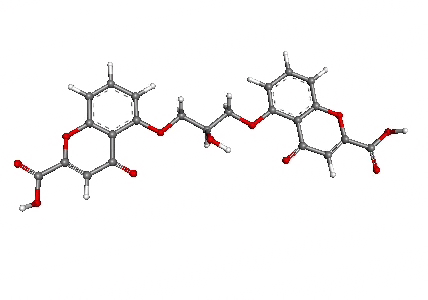License data US FDA: Cromolyn Bioavailability 1% | Molar mass 468.367 g/mol CAS ID 16110-51-3 | |
 | ||
AHFS/Drugs.com International Drug Names Pregnancycategory AU: B1US: B (No risk in non-human studies) ATC code A07EB01 (WHO) D11AH03 (WHO) R01AC01 (WHO) R03BC01 (WHO) S01GX01 (WHO) Legal status AU: S2 (Pharmacy only)UK: inhaler POM; eye OTCUS: OTC nasal; eye, inhaler: Rx only | ||
Cromoglicic acid (INN) (also referred to as cromolyn (USAN), cromoglycate (former BAN), or cromoglicate) is traditionally described as a mast cell stabilizer, and is commonly marketed as the sodium salt sodium cromoglicate or cromolyn sodium. This drug prevents the release of inflammatory chemicals such as histamine from mast cells.
Contents
Because of their convenience (and perceived safety), leukotriene receptor antagonists have largely replaced it as the non-corticosteroid treatment of choice in the treatment of asthma. Cromoglicic acid requires administration four times daily, and does not provide additive benefit in combination with inhaled corticosteroids.
History
Cromolyn sodium was discovered by Roger Altounyan who was himself a lifelong asthma sufferer. It is considered a breakthrough drug in management of asthma, as the patients can be freed from steroids in many cases; however, it is mainly effective as a prophylaxis for allergic and exercise-induced asthma, not as a treatment for acute attacks. Altounyan was investigating certain plants and herbs which have bronchodilating properties. One such plant was khella (Ammi visnaga) which had been used as a muscle relaxant since ancient times in Egypt. Altounyan deliberately inhaled derivatives of the active ingredient khellin to determine if they could block his asthma attacks. After several years of trial he isolated an effective and safe asthma-preventing compound called cromolyn sodium.
Preparations
Cromoglicic acid is available in multiple forms:
Mechanism of action
"Cromolyn works because it prevents the release of mediators that would normally attract inflammatory cells and because it stabilizes the inflammatory cells. MCT mast cells found in the mucosa are stabilised." Nedocromil is another mast cell stabilizer that also works in controlling asthma. The underlying mechanism of action is not fully understood; for while cromoglicate stabilizes mast cells, this mechanism is probably not why it works in asthma. Pharmaceutical companies have produced 20 related compounds that are equally or more potent at stabilising mast cells and none of them have shown any anti-asthmatic effect. It is more likely that these work by inhibiting the response of sensory C fibers to the irritant capsaicin, inhibiting local axon reflexes involved in asthma, and may inhibit the release of preformed T cell cytokines and mediators involved in asthma. (see review by Garland, 1991)
It is known to somewhat inhibit chloride channels (37% ± 7%) and thus may inhibit the:
Note: Another chemical (NPPB: 5-nitro-2(3-phenyl) propylamino-benzoic acid) was shown, in the same study, to be a more effective chloride channel blocker.
Finally it may act by inhibiting calcium influx.
Cromoglicate is classified as a chromone.
Cromolyn is also being tested as a drug to treat insulin-induced lipoatrophy. Cromolyn is also known to binds S100P protein and disrupts the interaction with RAGE.
